Marketing Report: Analysis of Boots' Strategies and Principles
VerifiedAdded on 2020/07/23
|13
|4248
|58
Report
AI Summary
This report provides a detailed analysis of the marketing principles employed by Boots, a prominent retail pharmacy chain. It begins by defining marketing and outlining the marketing process, including market analysis, target market selection, strategy development, and the marketing mix. The report then examines the benefits and costs of a marketing orientation, emphasizing customer-centric approaches. Task 2 delves into the influence of the external environment, including micro and macro factors, on marketing decisions. It assesses Boots' segmentation criteria, targeting strategies, and the impact of buyer behavior on marketing activities, concluding with a proposed new product positioning. Task 3 focuses on product development for competitive advantage, distribution strategies for customer convenience, price setting, promotional activities, and the extended marketing mix. Finally, Task 4 compares marketing mixes for different customer segments, differentiates between product and service marketing to businesses versus customers, and contrasts international and domestic marketing approaches. The report provides a comprehensive overview of Boots' marketing practices, offering valuable insights into its strategic decisions and their impact on consumer behavior and market performance.
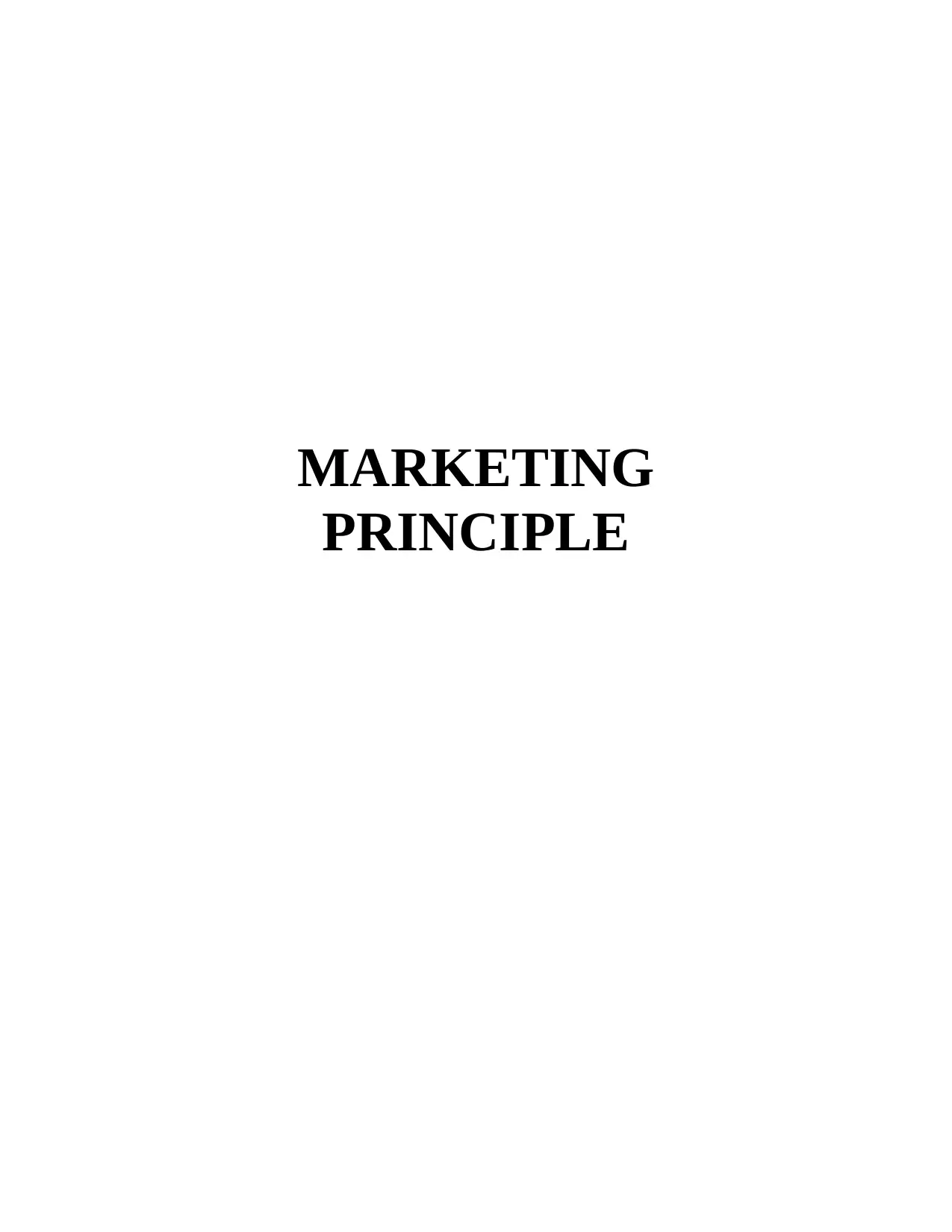
MARKETING
PRINCIPLE
PRINCIPLE
Paraphrase This Document
Need a fresh take? Get an instant paraphrase of this document with our AI Paraphraser
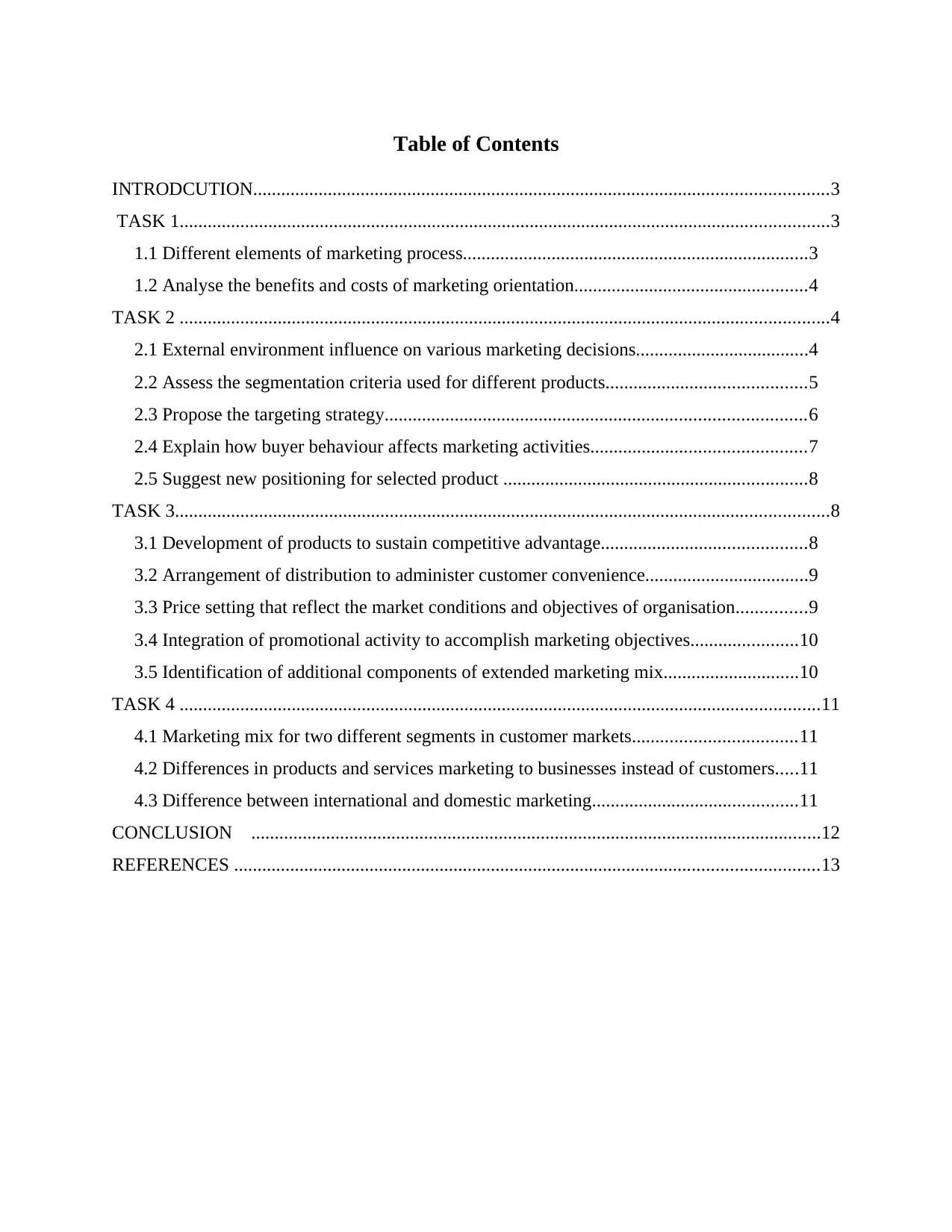
Table of Contents
INTRODCUTION...........................................................................................................................3
TASK 1...........................................................................................................................................3
1.1 Different elements of marketing process..........................................................................3
1.2 Analyse the benefits and costs of marketing orientation..................................................4
TASK 2 ...........................................................................................................................................4
2.1 External environment influence on various marketing decisions.....................................4
2.2 Assess the segmentation criteria used for different products...........................................5
2.3 Propose the targeting strategy..........................................................................................6
2.4 Explain how buyer behaviour affects marketing activities..............................................7
2.5 Suggest new positioning for selected product .................................................................8
TASK 3............................................................................................................................................8
3.1 Development of products to sustain competitive advantage............................................8
3.2 Arrangement of distribution to administer customer convenience...................................9
3.3 Price setting that reflect the market conditions and objectives of organisation...............9
3.4 Integration of promotional activity to accomplish marketing objectives.......................10
3.5 Identification of additional components of extended marketing mix.............................10
TASK 4 .........................................................................................................................................11
4.1 Marketing mix for two different segments in customer markets...................................11
4.2 Differences in products and services marketing to businesses instead of customers.....11
4.3 Difference between international and domestic marketing............................................11
CONCLUSION ..........................................................................................................................12
REFERENCES .............................................................................................................................13
INTRODCUTION...........................................................................................................................3
TASK 1...........................................................................................................................................3
1.1 Different elements of marketing process..........................................................................3
1.2 Analyse the benefits and costs of marketing orientation..................................................4
TASK 2 ...........................................................................................................................................4
2.1 External environment influence on various marketing decisions.....................................4
2.2 Assess the segmentation criteria used for different products...........................................5
2.3 Propose the targeting strategy..........................................................................................6
2.4 Explain how buyer behaviour affects marketing activities..............................................7
2.5 Suggest new positioning for selected product .................................................................8
TASK 3............................................................................................................................................8
3.1 Development of products to sustain competitive advantage............................................8
3.2 Arrangement of distribution to administer customer convenience...................................9
3.3 Price setting that reflect the market conditions and objectives of organisation...............9
3.4 Integration of promotional activity to accomplish marketing objectives.......................10
3.5 Identification of additional components of extended marketing mix.............................10
TASK 4 .........................................................................................................................................11
4.1 Marketing mix for two different segments in customer markets...................................11
4.2 Differences in products and services marketing to businesses instead of customers.....11
4.3 Difference between international and domestic marketing............................................11
CONCLUSION ..........................................................................................................................12
REFERENCES .............................................................................................................................13
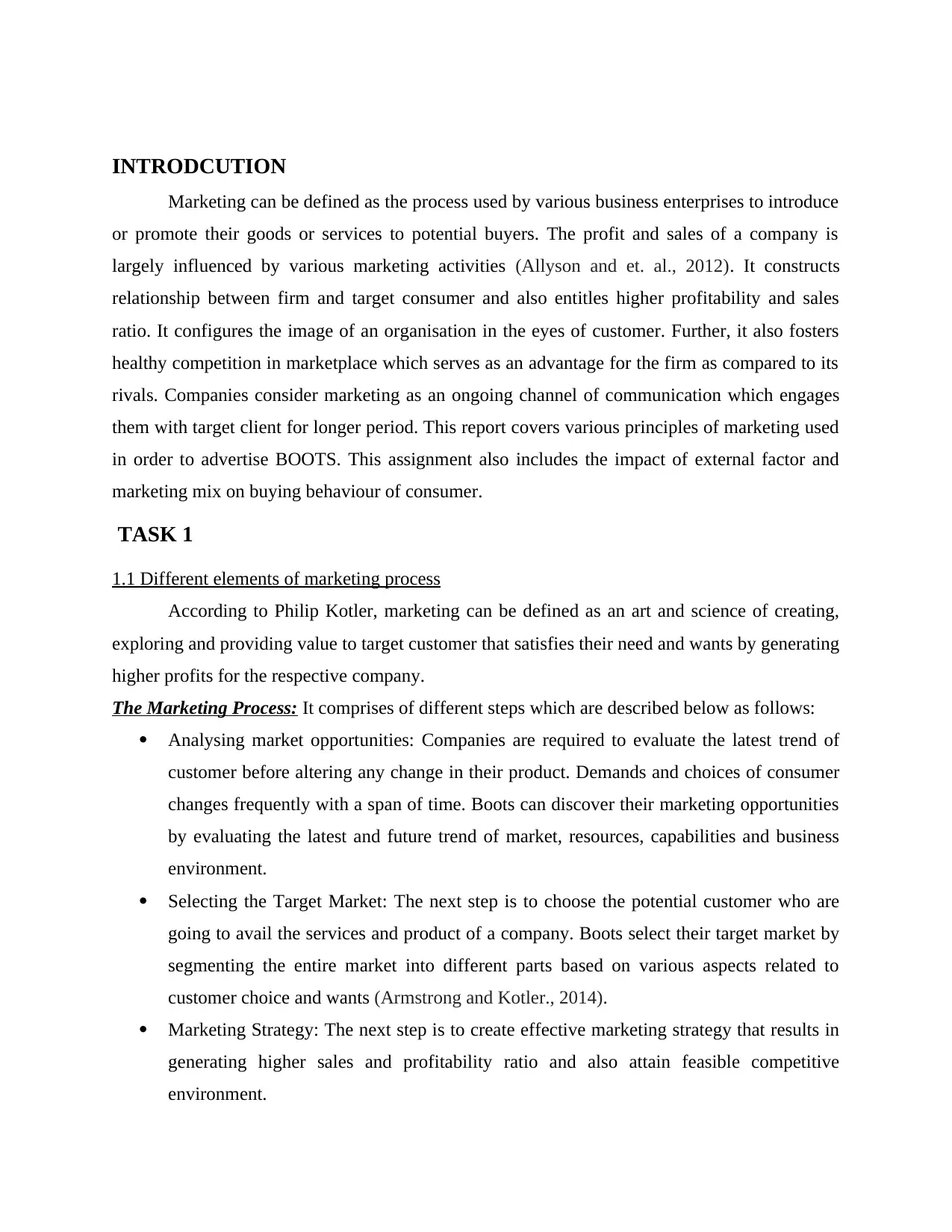
INTRODCUTION
Marketing can be defined as the process used by various business enterprises to introduce
or promote their goods or services to potential buyers. The profit and sales of a company is
largely influenced by various marketing activities (Allyson and et. al., 2012). It constructs
relationship between firm and target consumer and also entitles higher profitability and sales
ratio. It configures the image of an organisation in the eyes of customer. Further, it also fosters
healthy competition in marketplace which serves as an advantage for the firm as compared to its
rivals. Companies consider marketing as an ongoing channel of communication which engages
them with target client for longer period. This report covers various principles of marketing used
in order to advertise BOOTS. This assignment also includes the impact of external factor and
marketing mix on buying behaviour of consumer.
TASK 1
1.1 Different elements of marketing process
According to Philip Kotler, marketing can be defined as an art and science of creating,
exploring and providing value to target customer that satisfies their need and wants by generating
higher profits for the respective company.
The Marketing Process: It comprises of different steps which are described below as follows:
Analysing market opportunities: Companies are required to evaluate the latest trend of
customer before altering any change in their product. Demands and choices of consumer
changes frequently with a span of time. Boots can discover their marketing opportunities
by evaluating the latest and future trend of market, resources, capabilities and business
environment.
Selecting the Target Market: The next step is to choose the potential customer who are
going to avail the services and product of a company. Boots select their target market by
segmenting the entire market into different parts based on various aspects related to
customer choice and wants (Armstrong and Kotler., 2014).
Marketing Strategy: The next step is to create effective marketing strategy that results in
generating higher sales and profitability ratio and also attain feasible competitive
environment.
Marketing can be defined as the process used by various business enterprises to introduce
or promote their goods or services to potential buyers. The profit and sales of a company is
largely influenced by various marketing activities (Allyson and et. al., 2012). It constructs
relationship between firm and target consumer and also entitles higher profitability and sales
ratio. It configures the image of an organisation in the eyes of customer. Further, it also fosters
healthy competition in marketplace which serves as an advantage for the firm as compared to its
rivals. Companies consider marketing as an ongoing channel of communication which engages
them with target client for longer period. This report covers various principles of marketing used
in order to advertise BOOTS. This assignment also includes the impact of external factor and
marketing mix on buying behaviour of consumer.
TASK 1
1.1 Different elements of marketing process
According to Philip Kotler, marketing can be defined as an art and science of creating,
exploring and providing value to target customer that satisfies their need and wants by generating
higher profits for the respective company.
The Marketing Process: It comprises of different steps which are described below as follows:
Analysing market opportunities: Companies are required to evaluate the latest trend of
customer before altering any change in their product. Demands and choices of consumer
changes frequently with a span of time. Boots can discover their marketing opportunities
by evaluating the latest and future trend of market, resources, capabilities and business
environment.
Selecting the Target Market: The next step is to choose the potential customer who are
going to avail the services and product of a company. Boots select their target market by
segmenting the entire market into different parts based on various aspects related to
customer choice and wants (Armstrong and Kotler., 2014).
Marketing Strategy: The next step is to create effective marketing strategy that results in
generating higher sales and profitability ratio and also attain feasible competitive
environment.
⊘ This is a preview!⊘
Do you want full access?
Subscribe today to unlock all pages.

Trusted by 1+ million students worldwide
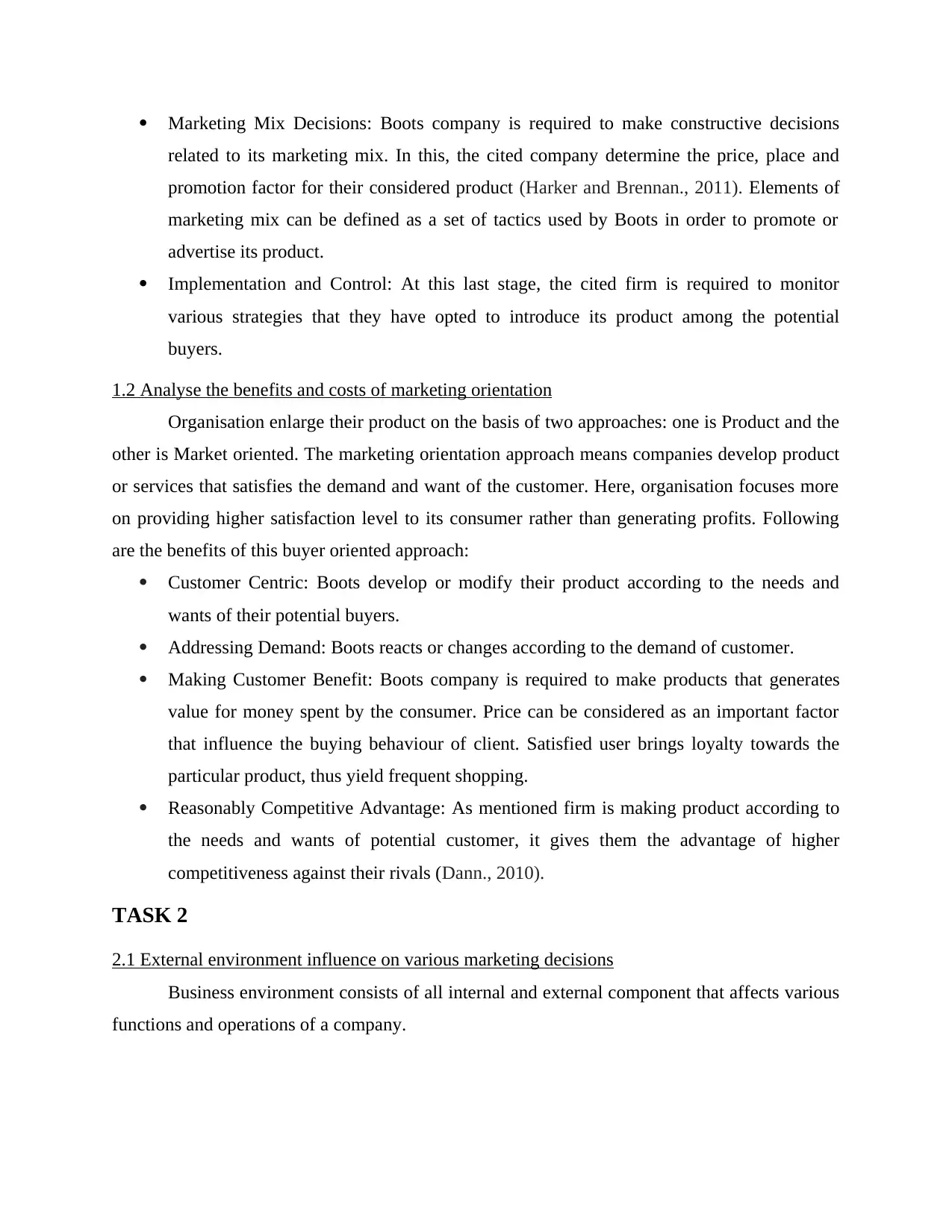
Marketing Mix Decisions: Boots company is required to make constructive decisions
related to its marketing mix. In this, the cited company determine the price, place and
promotion factor for their considered product (Harker and Brennan., 2011). Elements of
marketing mix can be defined as a set of tactics used by Boots in order to promote or
advertise its product.
Implementation and Control: At this last stage, the cited firm is required to monitor
various strategies that they have opted to introduce its product among the potential
buyers.
1.2 Analyse the benefits and costs of marketing orientation
Organisation enlarge their product on the basis of two approaches: one is Product and the
other is Market oriented. The marketing orientation approach means companies develop product
or services that satisfies the demand and want of the customer. Here, organisation focuses more
on providing higher satisfaction level to its consumer rather than generating profits. Following
are the benefits of this buyer oriented approach:
Customer Centric: Boots develop or modify their product according to the needs and
wants of their potential buyers.
Addressing Demand: Boots reacts or changes according to the demand of customer.
Making Customer Benefit: Boots company is required to make products that generates
value for money spent by the consumer. Price can be considered as an important factor
that influence the buying behaviour of client. Satisfied user brings loyalty towards the
particular product, thus yield frequent shopping.
Reasonably Competitive Advantage: As mentioned firm is making product according to
the needs and wants of potential customer, it gives them the advantage of higher
competitiveness against their rivals (Dann., 2010).
TASK 2
2.1 External environment influence on various marketing decisions
Business environment consists of all internal and external component that affects various
functions and operations of a company.
related to its marketing mix. In this, the cited company determine the price, place and
promotion factor for their considered product (Harker and Brennan., 2011). Elements of
marketing mix can be defined as a set of tactics used by Boots in order to promote or
advertise its product.
Implementation and Control: At this last stage, the cited firm is required to monitor
various strategies that they have opted to introduce its product among the potential
buyers.
1.2 Analyse the benefits and costs of marketing orientation
Organisation enlarge their product on the basis of two approaches: one is Product and the
other is Market oriented. The marketing orientation approach means companies develop product
or services that satisfies the demand and want of the customer. Here, organisation focuses more
on providing higher satisfaction level to its consumer rather than generating profits. Following
are the benefits of this buyer oriented approach:
Customer Centric: Boots develop or modify their product according to the needs and
wants of their potential buyers.
Addressing Demand: Boots reacts or changes according to the demand of customer.
Making Customer Benefit: Boots company is required to make products that generates
value for money spent by the consumer. Price can be considered as an important factor
that influence the buying behaviour of client. Satisfied user brings loyalty towards the
particular product, thus yield frequent shopping.
Reasonably Competitive Advantage: As mentioned firm is making product according to
the needs and wants of potential customer, it gives them the advantage of higher
competitiveness against their rivals (Dann., 2010).
TASK 2
2.1 External environment influence on various marketing decisions
Business environment consists of all internal and external component that affects various
functions and operations of a company.
Paraphrase This Document
Need a fresh take? Get an instant paraphrase of this document with our AI Paraphraser
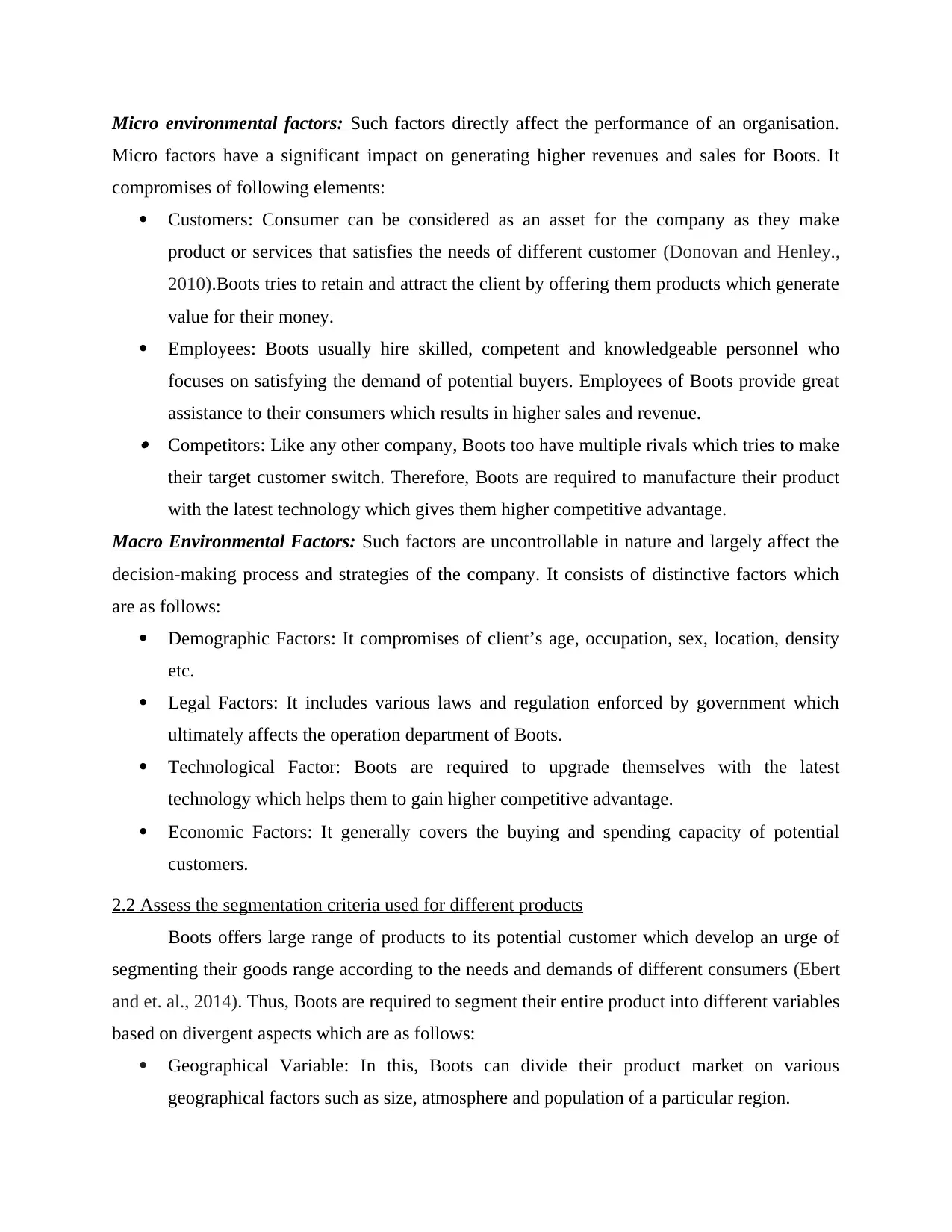
Micro environmental factors: Such factors directly affect the performance of an organisation.
Micro factors have a significant impact on generating higher revenues and sales for Boots. It
compromises of following elements:
Customers: Consumer can be considered as an asset for the company as they make
product or services that satisfies the needs of different customer (Donovan and Henley.,
2010).Boots tries to retain and attract the client by offering them products which generate
value for their money.
Employees: Boots usually hire skilled, competent and knowledgeable personnel who
focuses on satisfying the demand of potential buyers. Employees of Boots provide great
assistance to their consumers which results in higher sales and revenue. Competitors: Like any other company, Boots too have multiple rivals which tries to make
their target customer switch. Therefore, Boots are required to manufacture their product
with the latest technology which gives them higher competitive advantage.
Macro Environmental Factors: Such factors are uncontrollable in nature and largely affect the
decision-making process and strategies of the company. It consists of distinctive factors which
are as follows:
Demographic Factors: It compromises of client’s age, occupation, sex, location, density
etc.
Legal Factors: It includes various laws and regulation enforced by government which
ultimately affects the operation department of Boots.
Technological Factor: Boots are required to upgrade themselves with the latest
technology which helps them to gain higher competitive advantage.
Economic Factors: It generally covers the buying and spending capacity of potential
customers.
2.2 Assess the segmentation criteria used for different products
Boots offers large range of products to its potential customer which develop an urge of
segmenting their goods range according to the needs and demands of different consumers (Ebert
and et. al., 2014). Thus, Boots are required to segment their entire product into different variables
based on divergent aspects which are as follows:
Geographical Variable: In this, Boots can divide their product market on various
geographical factors such as size, atmosphere and population of a particular region.
Micro factors have a significant impact on generating higher revenues and sales for Boots. It
compromises of following elements:
Customers: Consumer can be considered as an asset for the company as they make
product or services that satisfies the needs of different customer (Donovan and Henley.,
2010).Boots tries to retain and attract the client by offering them products which generate
value for their money.
Employees: Boots usually hire skilled, competent and knowledgeable personnel who
focuses on satisfying the demand of potential buyers. Employees of Boots provide great
assistance to their consumers which results in higher sales and revenue. Competitors: Like any other company, Boots too have multiple rivals which tries to make
their target customer switch. Therefore, Boots are required to manufacture their product
with the latest technology which gives them higher competitive advantage.
Macro Environmental Factors: Such factors are uncontrollable in nature and largely affect the
decision-making process and strategies of the company. It consists of distinctive factors which
are as follows:
Demographic Factors: It compromises of client’s age, occupation, sex, location, density
etc.
Legal Factors: It includes various laws and regulation enforced by government which
ultimately affects the operation department of Boots.
Technological Factor: Boots are required to upgrade themselves with the latest
technology which helps them to gain higher competitive advantage.
Economic Factors: It generally covers the buying and spending capacity of potential
customers.
2.2 Assess the segmentation criteria used for different products
Boots offers large range of products to its potential customer which develop an urge of
segmenting their goods range according to the needs and demands of different consumers (Ebert
and et. al., 2014). Thus, Boots are required to segment their entire product into different variables
based on divergent aspects which are as follows:
Geographical Variable: In this, Boots can divide their product market on various
geographical factors such as size, atmosphere and population of a particular region.
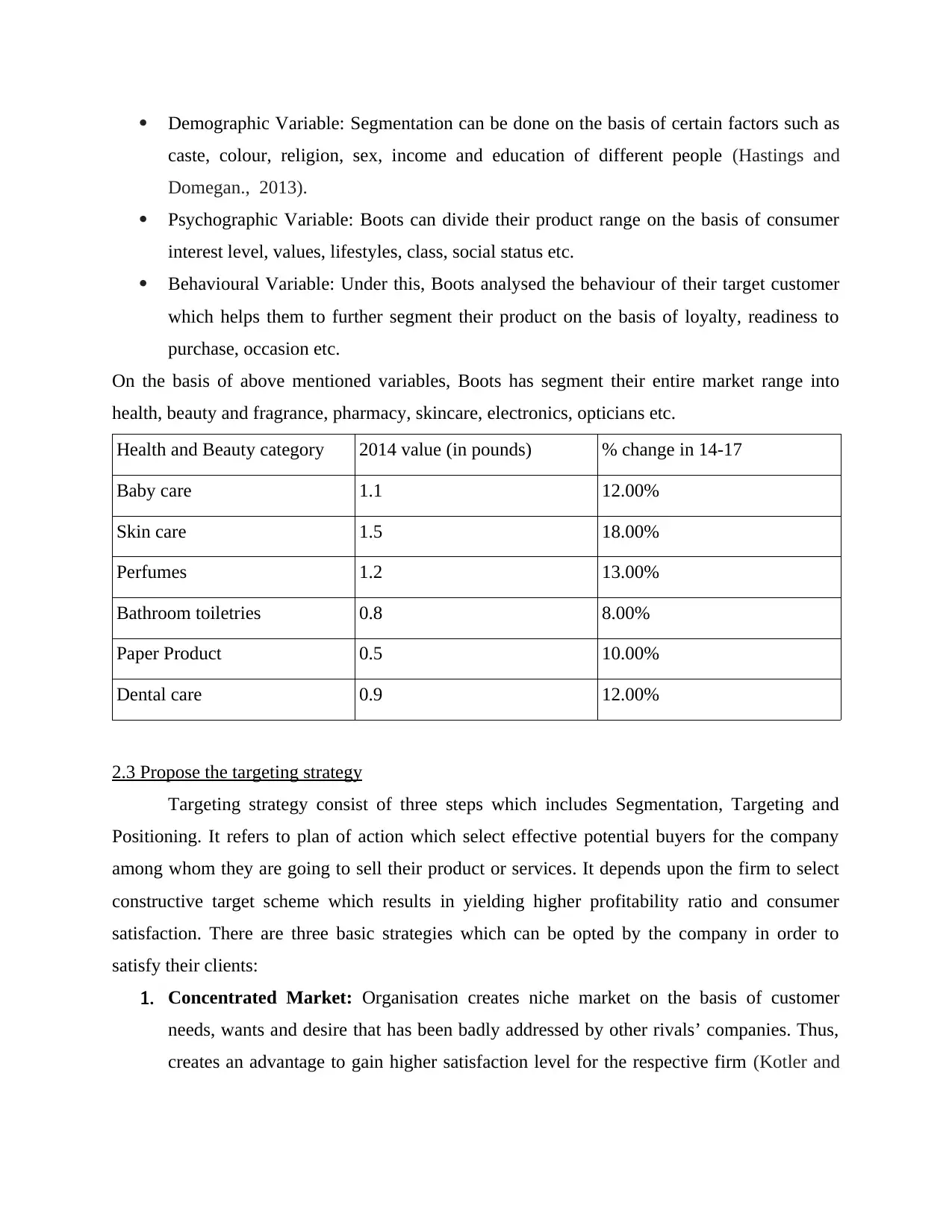
Demographic Variable: Segmentation can be done on the basis of certain factors such as
caste, colour, religion, sex, income and education of different people (Hastings and
Domegan., 2013).
Psychographic Variable: Boots can divide their product range on the basis of consumer
interest level, values, lifestyles, class, social status etc.
Behavioural Variable: Under this, Boots analysed the behaviour of their target customer
which helps them to further segment their product on the basis of loyalty, readiness to
purchase, occasion etc.
On the basis of above mentioned variables, Boots has segment their entire market range into
health, beauty and fragrance, pharmacy, skincare, electronics, opticians etc.
Health and Beauty category 2014 value (in pounds) % change in 14-17
Baby care 1.1 12.00%
Skin care 1.5 18.00%
Perfumes 1.2 13.00%
Bathroom toiletries 0.8 8.00%
Paper Product 0.5 10.00%
Dental care 0.9 12.00%
2.3 Propose the targeting strategy
Targeting strategy consist of three steps which includes Segmentation, Targeting and
Positioning. It refers to plan of action which select effective potential buyers for the company
among whom they are going to sell their product or services. It depends upon the firm to select
constructive target scheme which results in yielding higher profitability ratio and consumer
satisfaction. There are three basic strategies which can be opted by the company in order to
satisfy their clients:
1. Concentrated Market: Organisation creates niche market on the basis of customer
needs, wants and desire that has been badly addressed by other rivals’ companies. Thus,
creates an advantage to gain higher satisfaction level for the respective firm (Kotler and
caste, colour, religion, sex, income and education of different people (Hastings and
Domegan., 2013).
Psychographic Variable: Boots can divide their product range on the basis of consumer
interest level, values, lifestyles, class, social status etc.
Behavioural Variable: Under this, Boots analysed the behaviour of their target customer
which helps them to further segment their product on the basis of loyalty, readiness to
purchase, occasion etc.
On the basis of above mentioned variables, Boots has segment their entire market range into
health, beauty and fragrance, pharmacy, skincare, electronics, opticians etc.
Health and Beauty category 2014 value (in pounds) % change in 14-17
Baby care 1.1 12.00%
Skin care 1.5 18.00%
Perfumes 1.2 13.00%
Bathroom toiletries 0.8 8.00%
Paper Product 0.5 10.00%
Dental care 0.9 12.00%
2.3 Propose the targeting strategy
Targeting strategy consist of three steps which includes Segmentation, Targeting and
Positioning. It refers to plan of action which select effective potential buyers for the company
among whom they are going to sell their product or services. It depends upon the firm to select
constructive target scheme which results in yielding higher profitability ratio and consumer
satisfaction. There are three basic strategies which can be opted by the company in order to
satisfy their clients:
1. Concentrated Market: Organisation creates niche market on the basis of customer
needs, wants and desire that has been badly addressed by other rivals’ companies. Thus,
creates an advantage to gain higher satisfaction level for the respective firm (Kotler and
⊘ This is a preview!⊘
Do you want full access?
Subscribe today to unlock all pages.

Trusted by 1+ million students worldwide
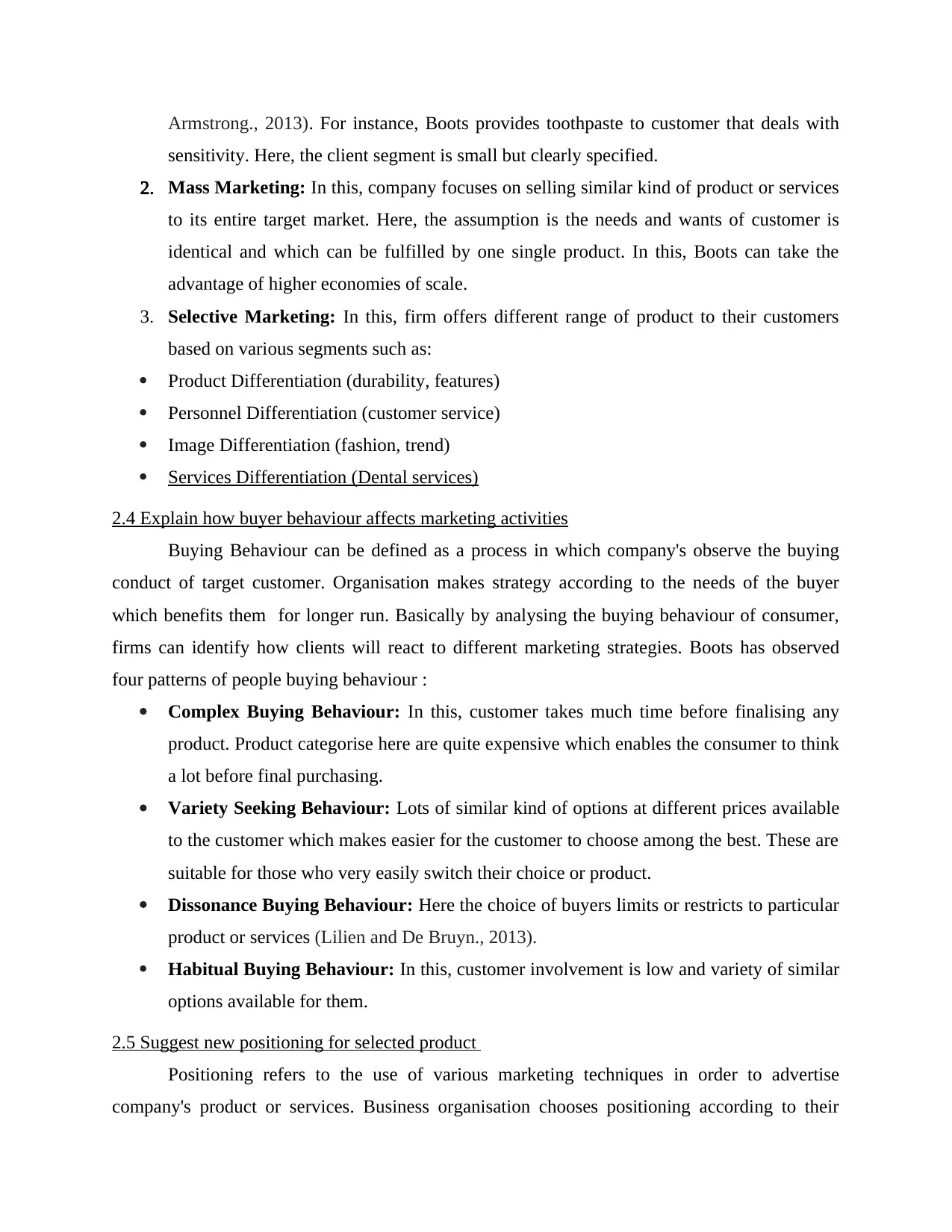
Armstrong., 2013). For instance, Boots provides toothpaste to customer that deals with
sensitivity. Here, the client segment is small but clearly specified.
2. Mass Marketing: In this, company focuses on selling similar kind of product or services
to its entire target market. Here, the assumption is the needs and wants of customer is
identical and which can be fulfilled by one single product. In this, Boots can take the
advantage of higher economies of scale.
3. Selective Marketing: In this, firm offers different range of product to their customers
based on various segments such as:
Product Differentiation (durability, features)
Personnel Differentiation (customer service)
Image Differentiation (fashion, trend)
Services Differentiation (Dental services)
2.4 Explain how buyer behaviour affects marketing activities
Buying Behaviour can be defined as a process in which company's observe the buying
conduct of target customer. Organisation makes strategy according to the needs of the buyer
which benefits them for longer run. Basically by analysing the buying behaviour of consumer,
firms can identify how clients will react to different marketing strategies. Boots has observed
four patterns of people buying behaviour :
Complex Buying Behaviour: In this, customer takes much time before finalising any
product. Product categorise here are quite expensive which enables the consumer to think
a lot before final purchasing.
Variety Seeking Behaviour: Lots of similar kind of options at different prices available
to the customer which makes easier for the customer to choose among the best. These are
suitable for those who very easily switch their choice or product.
Dissonance Buying Behaviour: Here the choice of buyers limits or restricts to particular
product or services (Lilien and De Bruyn., 2013).
Habitual Buying Behaviour: In this, customer involvement is low and variety of similar
options available for them.
2.5 Suggest new positioning for selected product
Positioning refers to the use of various marketing techniques in order to advertise
company's product or services. Business organisation chooses positioning according to their
sensitivity. Here, the client segment is small but clearly specified.
2. Mass Marketing: In this, company focuses on selling similar kind of product or services
to its entire target market. Here, the assumption is the needs and wants of customer is
identical and which can be fulfilled by one single product. In this, Boots can take the
advantage of higher economies of scale.
3. Selective Marketing: In this, firm offers different range of product to their customers
based on various segments such as:
Product Differentiation (durability, features)
Personnel Differentiation (customer service)
Image Differentiation (fashion, trend)
Services Differentiation (Dental services)
2.4 Explain how buyer behaviour affects marketing activities
Buying Behaviour can be defined as a process in which company's observe the buying
conduct of target customer. Organisation makes strategy according to the needs of the buyer
which benefits them for longer run. Basically by analysing the buying behaviour of consumer,
firms can identify how clients will react to different marketing strategies. Boots has observed
four patterns of people buying behaviour :
Complex Buying Behaviour: In this, customer takes much time before finalising any
product. Product categorise here are quite expensive which enables the consumer to think
a lot before final purchasing.
Variety Seeking Behaviour: Lots of similar kind of options at different prices available
to the customer which makes easier for the customer to choose among the best. These are
suitable for those who very easily switch their choice or product.
Dissonance Buying Behaviour: Here the choice of buyers limits or restricts to particular
product or services (Lilien and De Bruyn., 2013).
Habitual Buying Behaviour: In this, customer involvement is low and variety of similar
options available for them.
2.5 Suggest new positioning for selected product
Positioning refers to the use of various marketing techniques in order to advertise
company's product or services. Business organisation chooses positioning according to their
Paraphrase This Document
Need a fresh take? Get an instant paraphrase of this document with our AI Paraphraser
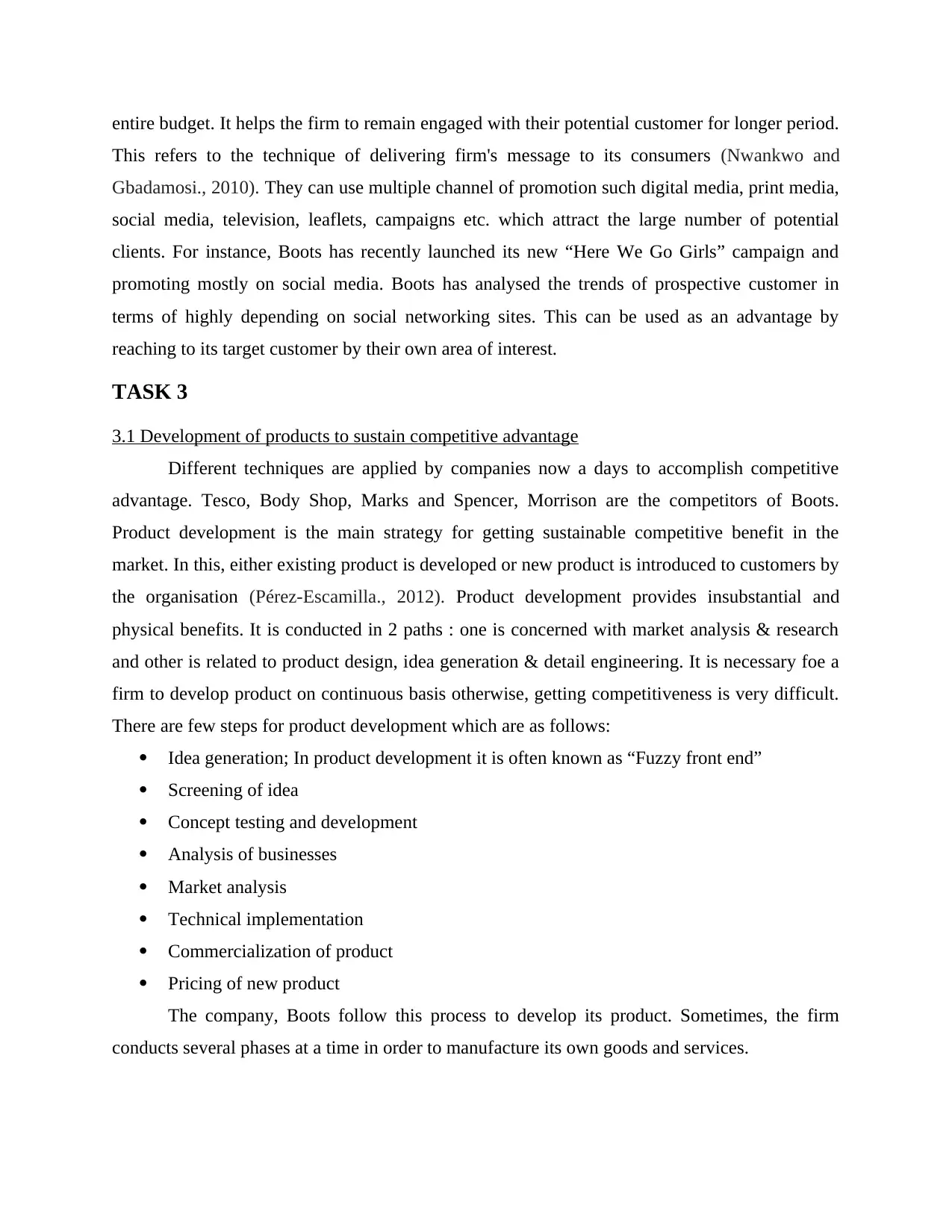
entire budget. It helps the firm to remain engaged with their potential customer for longer period.
This refers to the technique of delivering firm's message to its consumers (Nwankwo and
Gbadamosi., 2010). They can use multiple channel of promotion such digital media, print media,
social media, television, leaflets, campaigns etc. which attract the large number of potential
clients. For instance, Boots has recently launched its new “Here We Go Girls” campaign and
promoting mostly on social media. Boots has analysed the trends of prospective customer in
terms of highly depending on social networking sites. This can be used as an advantage by
reaching to its target customer by their own area of interest.
TASK 3
3.1 Development of products to sustain competitive advantage
Different techniques are applied by companies now a days to accomplish competitive
advantage. Tesco, Body Shop, Marks and Spencer, Morrison are the competitors of Boots.
Product development is the main strategy for getting sustainable competitive benefit in the
market. In this, either existing product is developed or new product is introduced to customers by
the organisation (Pérez-Escamilla., 2012). Product development provides insubstantial and
physical benefits. It is conducted in 2 paths : one is concerned with market analysis & research
and other is related to product design, idea generation & detail engineering. It is necessary foe a
firm to develop product on continuous basis otherwise, getting competitiveness is very difficult.
There are few steps for product development which are as follows:
Idea generation; In product development it is often known as “Fuzzy front end”
Screening of idea
Concept testing and development
Analysis of businesses
Market analysis
Technical implementation
Commercialization of product
Pricing of new product
The company, Boots follow this process to develop its product. Sometimes, the firm
conducts several phases at a time in order to manufacture its own goods and services.
This refers to the technique of delivering firm's message to its consumers (Nwankwo and
Gbadamosi., 2010). They can use multiple channel of promotion such digital media, print media,
social media, television, leaflets, campaigns etc. which attract the large number of potential
clients. For instance, Boots has recently launched its new “Here We Go Girls” campaign and
promoting mostly on social media. Boots has analysed the trends of prospective customer in
terms of highly depending on social networking sites. This can be used as an advantage by
reaching to its target customer by their own area of interest.
TASK 3
3.1 Development of products to sustain competitive advantage
Different techniques are applied by companies now a days to accomplish competitive
advantage. Tesco, Body Shop, Marks and Spencer, Morrison are the competitors of Boots.
Product development is the main strategy for getting sustainable competitive benefit in the
market. In this, either existing product is developed or new product is introduced to customers by
the organisation (Pérez-Escamilla., 2012). Product development provides insubstantial and
physical benefits. It is conducted in 2 paths : one is concerned with market analysis & research
and other is related to product design, idea generation & detail engineering. It is necessary foe a
firm to develop product on continuous basis otherwise, getting competitiveness is very difficult.
There are few steps for product development which are as follows:
Idea generation; In product development it is often known as “Fuzzy front end”
Screening of idea
Concept testing and development
Analysis of businesses
Market analysis
Technical implementation
Commercialization of product
Pricing of new product
The company, Boots follow this process to develop its product. Sometimes, the firm
conducts several phases at a time in order to manufacture its own goods and services.
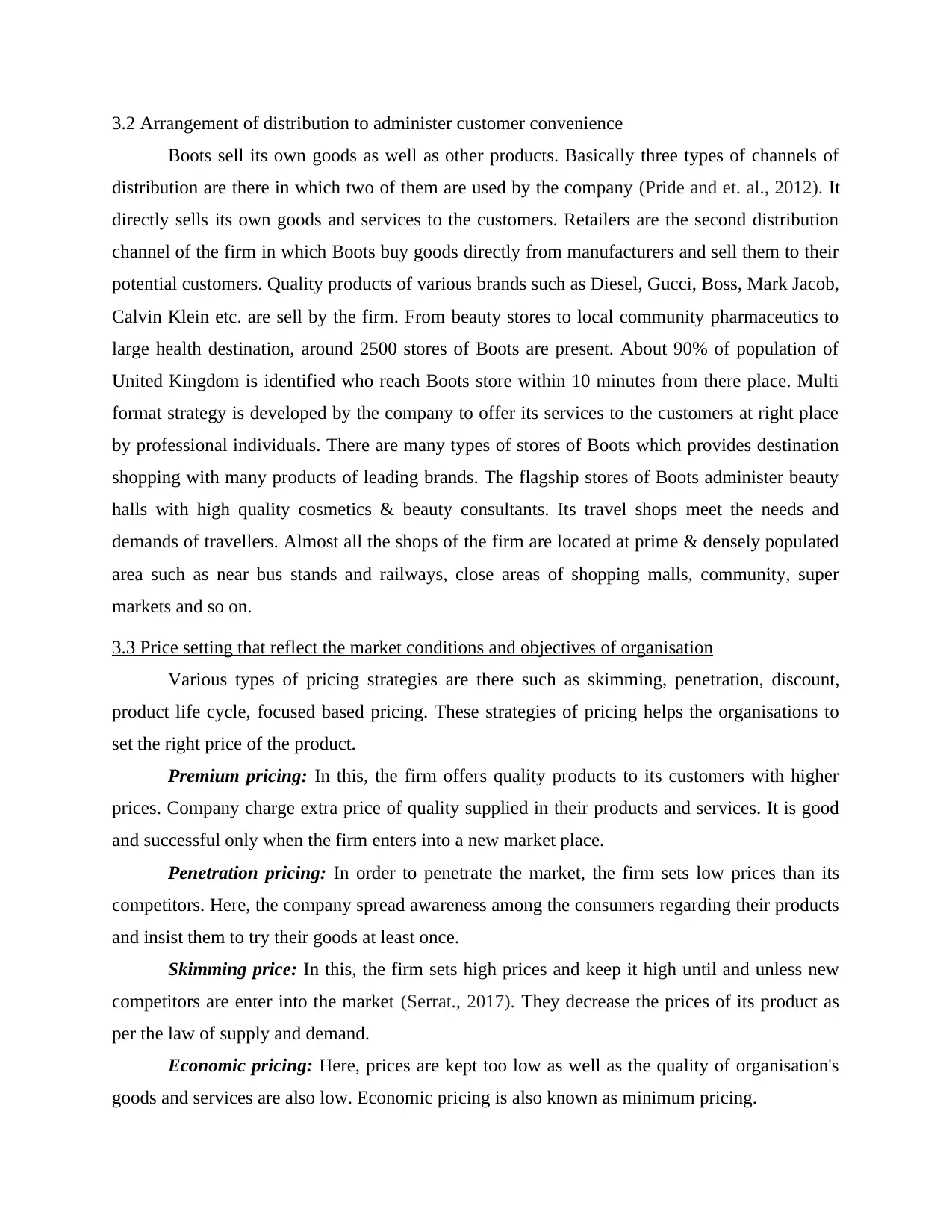
3.2 Arrangement of distribution to administer customer convenience
Boots sell its own goods as well as other products. Basically three types of channels of
distribution are there in which two of them are used by the company (Pride and et. al., 2012). It
directly sells its own goods and services to the customers. Retailers are the second distribution
channel of the firm in which Boots buy goods directly from manufacturers and sell them to their
potential customers. Quality products of various brands such as Diesel, Gucci, Boss, Mark Jacob,
Calvin Klein etc. are sell by the firm. From beauty stores to local community pharmaceutics to
large health destination, around 2500 stores of Boots are present. About 90% of population of
United Kingdom is identified who reach Boots store within 10 minutes from there place. Multi
format strategy is developed by the company to offer its services to the customers at right place
by professional individuals. There are many types of stores of Boots which provides destination
shopping with many products of leading brands. The flagship stores of Boots administer beauty
halls with high quality cosmetics & beauty consultants. Its travel shops meet the needs and
demands of travellers. Almost all the shops of the firm are located at prime & densely populated
area such as near bus stands and railways, close areas of shopping malls, community, super
markets and so on.
3.3 Price setting that reflect the market conditions and objectives of organisation
Various types of pricing strategies are there such as skimming, penetration, discount,
product life cycle, focused based pricing. These strategies of pricing helps the organisations to
set the right price of the product.
Premium pricing: In this, the firm offers quality products to its customers with higher
prices. Company charge extra price of quality supplied in their products and services. It is good
and successful only when the firm enters into a new market place.
Penetration pricing: In order to penetrate the market, the firm sets low prices than its
competitors. Here, the company spread awareness among the consumers regarding their products
and insist them to try their goods at least once.
Skimming price: In this, the firm sets high prices and keep it high until and unless new
competitors are enter into the market (Serrat., 2017). They decrease the prices of its product as
per the law of supply and demand.
Economic pricing: Here, prices are kept too low as well as the quality of organisation's
goods and services are also low. Economic pricing is also known as minimum pricing.
Boots sell its own goods as well as other products. Basically three types of channels of
distribution are there in which two of them are used by the company (Pride and et. al., 2012). It
directly sells its own goods and services to the customers. Retailers are the second distribution
channel of the firm in which Boots buy goods directly from manufacturers and sell them to their
potential customers. Quality products of various brands such as Diesel, Gucci, Boss, Mark Jacob,
Calvin Klein etc. are sell by the firm. From beauty stores to local community pharmaceutics to
large health destination, around 2500 stores of Boots are present. About 90% of population of
United Kingdom is identified who reach Boots store within 10 minutes from there place. Multi
format strategy is developed by the company to offer its services to the customers at right place
by professional individuals. There are many types of stores of Boots which provides destination
shopping with many products of leading brands. The flagship stores of Boots administer beauty
halls with high quality cosmetics & beauty consultants. Its travel shops meet the needs and
demands of travellers. Almost all the shops of the firm are located at prime & densely populated
area such as near bus stands and railways, close areas of shopping malls, community, super
markets and so on.
3.3 Price setting that reflect the market conditions and objectives of organisation
Various types of pricing strategies are there such as skimming, penetration, discount,
product life cycle, focused based pricing. These strategies of pricing helps the organisations to
set the right price of the product.
Premium pricing: In this, the firm offers quality products to its customers with higher
prices. Company charge extra price of quality supplied in their products and services. It is good
and successful only when the firm enters into a new market place.
Penetration pricing: In order to penetrate the market, the firm sets low prices than its
competitors. Here, the company spread awareness among the consumers regarding their products
and insist them to try their goods at least once.
Skimming price: In this, the firm sets high prices and keep it high until and unless new
competitors are enter into the market (Serrat., 2017). They decrease the prices of its product as
per the law of supply and demand.
Economic pricing: Here, prices are kept too low as well as the quality of organisation's
goods and services are also low. Economic pricing is also known as minimum pricing.
⊘ This is a preview!⊘
Do you want full access?
Subscribe today to unlock all pages.

Trusted by 1+ million students worldwide
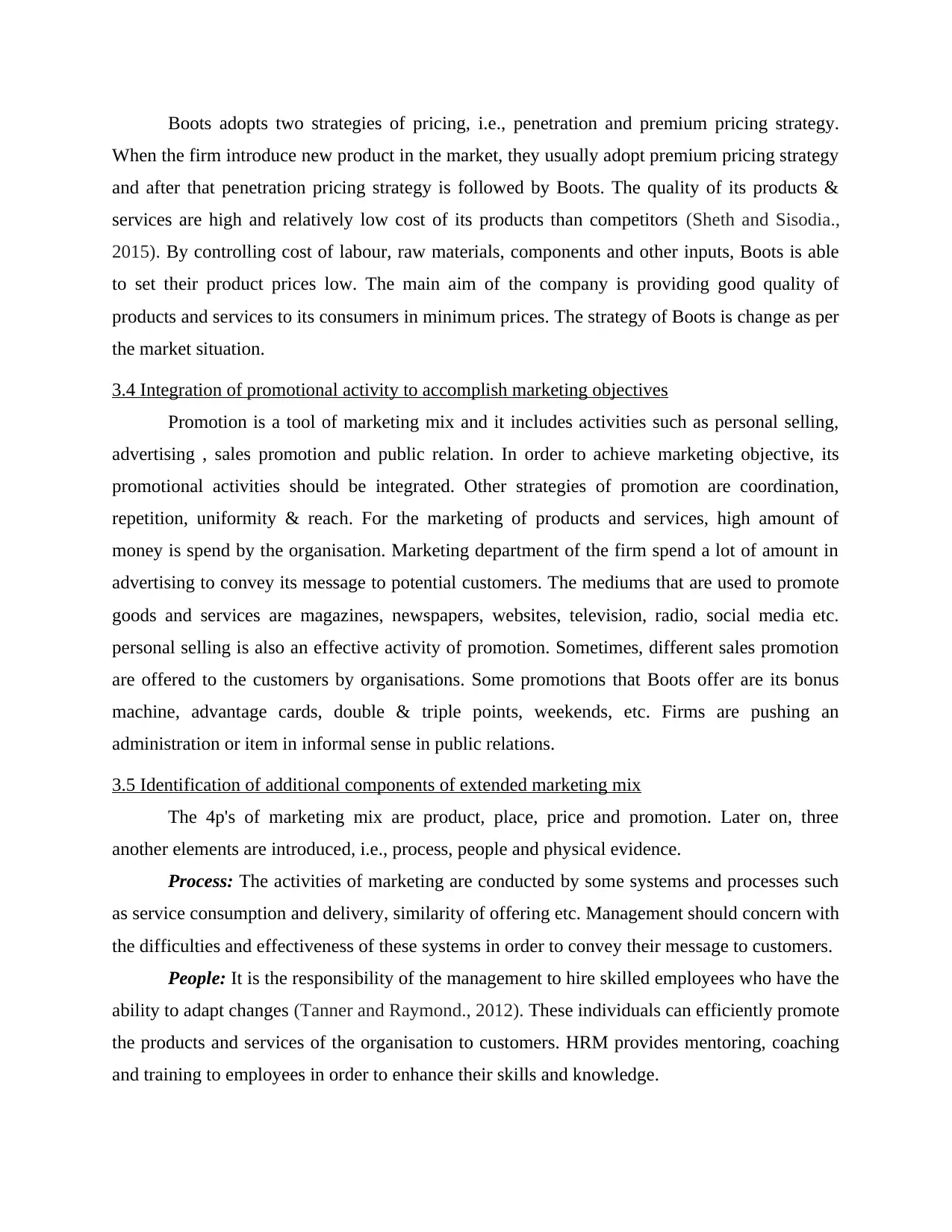
Boots adopts two strategies of pricing, i.e., penetration and premium pricing strategy.
When the firm introduce new product in the market, they usually adopt premium pricing strategy
and after that penetration pricing strategy is followed by Boots. The quality of its products &
services are high and relatively low cost of its products than competitors (Sheth and Sisodia.,
2015). By controlling cost of labour, raw materials, components and other inputs, Boots is able
to set their product prices low. The main aim of the company is providing good quality of
products and services to its consumers in minimum prices. The strategy of Boots is change as per
the market situation.
3.4 Integration of promotional activity to accomplish marketing objectives
Promotion is a tool of marketing mix and it includes activities such as personal selling,
advertising , sales promotion and public relation. In order to achieve marketing objective, its
promotional activities should be integrated. Other strategies of promotion are coordination,
repetition, uniformity & reach. For the marketing of products and services, high amount of
money is spend by the organisation. Marketing department of the firm spend a lot of amount in
advertising to convey its message to potential customers. The mediums that are used to promote
goods and services are magazines, newspapers, websites, television, radio, social media etc.
personal selling is also an effective activity of promotion. Sometimes, different sales promotion
are offered to the customers by organisations. Some promotions that Boots offer are its bonus
machine, advantage cards, double & triple points, weekends, etc. Firms are pushing an
administration or item in informal sense in public relations.
3.5 Identification of additional components of extended marketing mix
The 4p's of marketing mix are product, place, price and promotion. Later on, three
another elements are introduced, i.e., process, people and physical evidence.
Process: The activities of marketing are conducted by some systems and processes such
as service consumption and delivery, similarity of offering etc. Management should concern with
the difficulties and effectiveness of these systems in order to convey their message to customers.
People: It is the responsibility of the management to hire skilled employees who have the
ability to adapt changes (Tanner and Raymond., 2012). These individuals can efficiently promote
the products and services of the organisation to customers. HRM provides mentoring, coaching
and training to employees in order to enhance their skills and knowledge.
When the firm introduce new product in the market, they usually adopt premium pricing strategy
and after that penetration pricing strategy is followed by Boots. The quality of its products &
services are high and relatively low cost of its products than competitors (Sheth and Sisodia.,
2015). By controlling cost of labour, raw materials, components and other inputs, Boots is able
to set their product prices low. The main aim of the company is providing good quality of
products and services to its consumers in minimum prices. The strategy of Boots is change as per
the market situation.
3.4 Integration of promotional activity to accomplish marketing objectives
Promotion is a tool of marketing mix and it includes activities such as personal selling,
advertising , sales promotion and public relation. In order to achieve marketing objective, its
promotional activities should be integrated. Other strategies of promotion are coordination,
repetition, uniformity & reach. For the marketing of products and services, high amount of
money is spend by the organisation. Marketing department of the firm spend a lot of amount in
advertising to convey its message to potential customers. The mediums that are used to promote
goods and services are magazines, newspapers, websites, television, radio, social media etc.
personal selling is also an effective activity of promotion. Sometimes, different sales promotion
are offered to the customers by organisations. Some promotions that Boots offer are its bonus
machine, advantage cards, double & triple points, weekends, etc. Firms are pushing an
administration or item in informal sense in public relations.
3.5 Identification of additional components of extended marketing mix
The 4p's of marketing mix are product, place, price and promotion. Later on, three
another elements are introduced, i.e., process, people and physical evidence.
Process: The activities of marketing are conducted by some systems and processes such
as service consumption and delivery, similarity of offering etc. Management should concern with
the difficulties and effectiveness of these systems in order to convey their message to customers.
People: It is the responsibility of the management to hire skilled employees who have the
ability to adapt changes (Tanner and Raymond., 2012). These individuals can efficiently promote
the products and services of the organisation to customers. HRM provides mentoring, coaching
and training to employees in order to enhance their skills and knowledge.
Paraphrase This Document
Need a fresh take? Get an instant paraphrase of this document with our AI Paraphraser
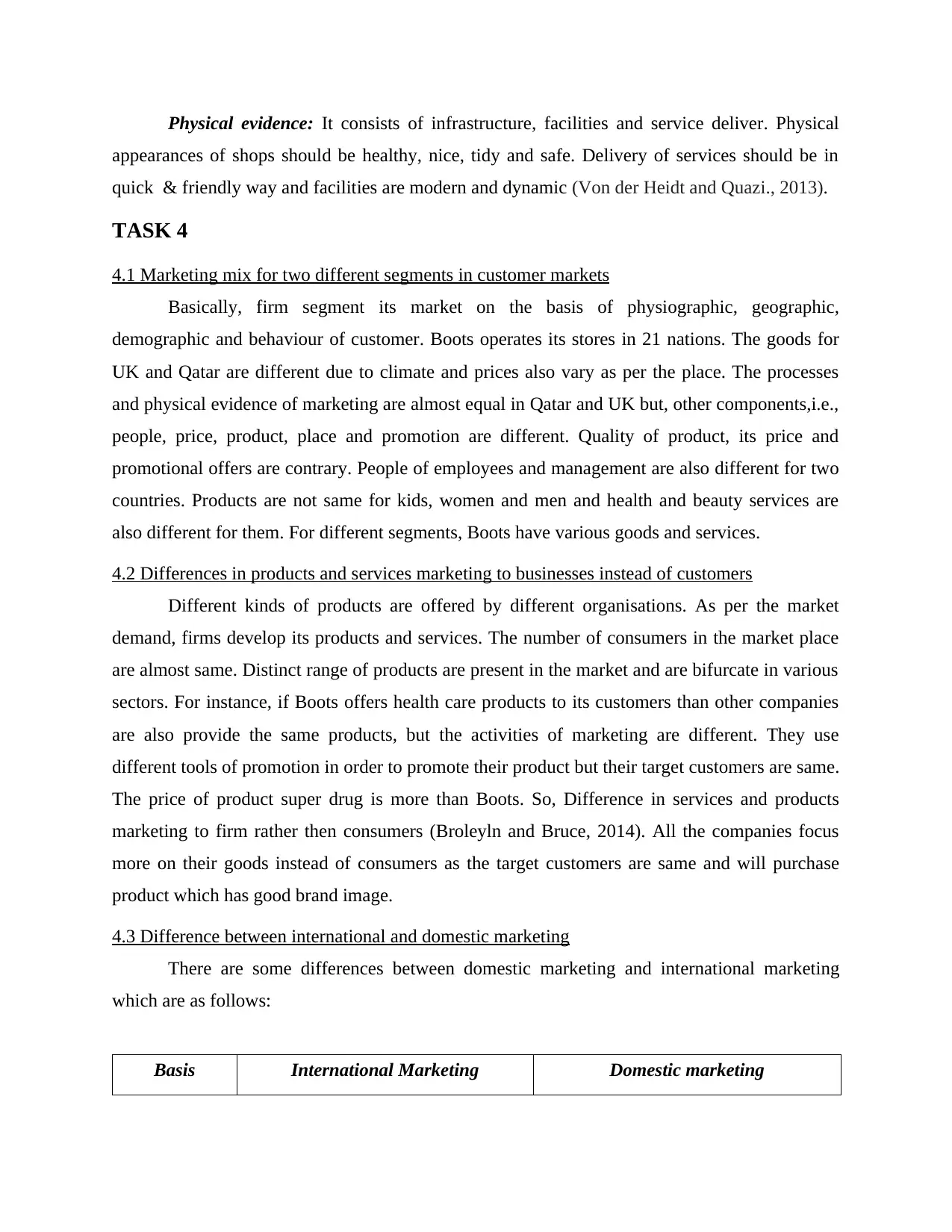
Physical evidence: It consists of infrastructure, facilities and service deliver. Physical
appearances of shops should be healthy, nice, tidy and safe. Delivery of services should be in
quick & friendly way and facilities are modern and dynamic (Von der Heidt and Quazi., 2013).
TASK 4
4.1 Marketing mix for two different segments in customer markets
Basically, firm segment its market on the basis of physiographic, geographic,
demographic and behaviour of customer. Boots operates its stores in 21 nations. The goods for
UK and Qatar are different due to climate and prices also vary as per the place. The processes
and physical evidence of marketing are almost equal in Qatar and UK but, other components,i.e.,
people, price, product, place and promotion are different. Quality of product, its price and
promotional offers are contrary. People of employees and management are also different for two
countries. Products are not same for kids, women and men and health and beauty services are
also different for them. For different segments, Boots have various goods and services.
4.2 Differences in products and services marketing to businesses instead of customers
Different kinds of products are offered by different organisations. As per the market
demand, firms develop its products and services. The number of consumers in the market place
are almost same. Distinct range of products are present in the market and are bifurcate in various
sectors. For instance, if Boots offers health care products to its customers than other companies
are also provide the same products, but the activities of marketing are different. They use
different tools of promotion in order to promote their product but their target customers are same.
The price of product super drug is more than Boots. So, Difference in services and products
marketing to firm rather then consumers (Broleyln and Bruce, 2014). All the companies focus
more on their goods instead of consumers as the target customers are same and will purchase
product which has good brand image.
4.3 Difference between international and domestic marketing
There are some differences between domestic marketing and international marketing
which are as follows:
Basis International Marketing Domestic marketing
appearances of shops should be healthy, nice, tidy and safe. Delivery of services should be in
quick & friendly way and facilities are modern and dynamic (Von der Heidt and Quazi., 2013).
TASK 4
4.1 Marketing mix for two different segments in customer markets
Basically, firm segment its market on the basis of physiographic, geographic,
demographic and behaviour of customer. Boots operates its stores in 21 nations. The goods for
UK and Qatar are different due to climate and prices also vary as per the place. The processes
and physical evidence of marketing are almost equal in Qatar and UK but, other components,i.e.,
people, price, product, place and promotion are different. Quality of product, its price and
promotional offers are contrary. People of employees and management are also different for two
countries. Products are not same for kids, women and men and health and beauty services are
also different for them. For different segments, Boots have various goods and services.
4.2 Differences in products and services marketing to businesses instead of customers
Different kinds of products are offered by different organisations. As per the market
demand, firms develop its products and services. The number of consumers in the market place
are almost same. Distinct range of products are present in the market and are bifurcate in various
sectors. For instance, if Boots offers health care products to its customers than other companies
are also provide the same products, but the activities of marketing are different. They use
different tools of promotion in order to promote their product but their target customers are same.
The price of product super drug is more than Boots. So, Difference in services and products
marketing to firm rather then consumers (Broleyln and Bruce, 2014). All the companies focus
more on their goods instead of consumers as the target customers are same and will purchase
product which has good brand image.
4.3 Difference between international and domestic marketing
There are some differences between domestic marketing and international marketing
which are as follows:
Basis International Marketing Domestic marketing
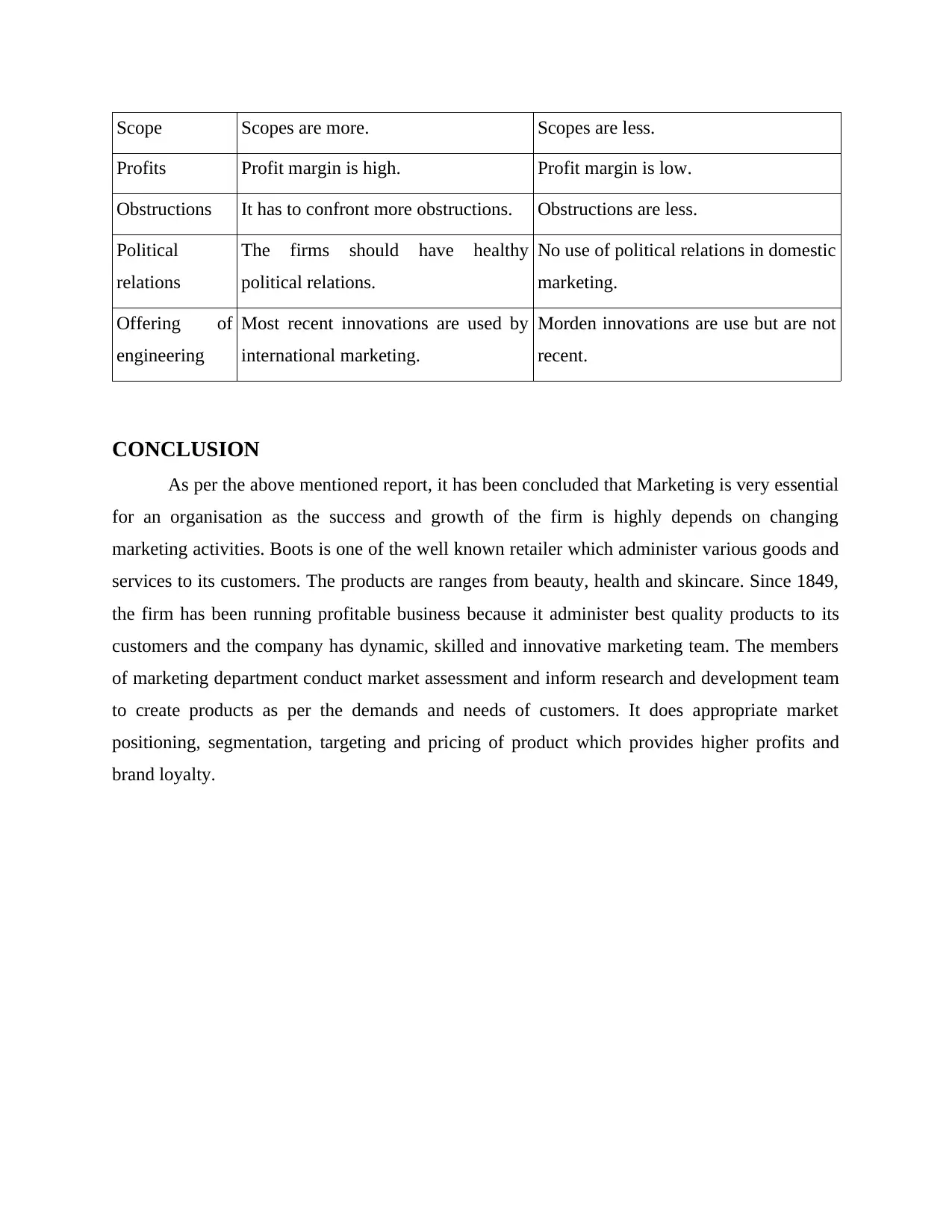
Scope Scopes are more. Scopes are less.
Profits Profit margin is high. Profit margin is low.
Obstructions It has to confront more obstructions. Obstructions are less.
Political
relations
The firms should have healthy
political relations.
No use of political relations in domestic
marketing.
Offering of
engineering
Most recent innovations are used by
international marketing.
Morden innovations are use but are not
recent.
CONCLUSION
As per the above mentioned report, it has been concluded that Marketing is very essential
for an organisation as the success and growth of the firm is highly depends on changing
marketing activities. Boots is one of the well known retailer which administer various goods and
services to its customers. The products are ranges from beauty, health and skincare. Since 1849,
the firm has been running profitable business because it administer best quality products to its
customers and the company has dynamic, skilled and innovative marketing team. The members
of marketing department conduct market assessment and inform research and development team
to create products as per the demands and needs of customers. It does appropriate market
positioning, segmentation, targeting and pricing of product which provides higher profits and
brand loyalty.
Profits Profit margin is high. Profit margin is low.
Obstructions It has to confront more obstructions. Obstructions are less.
Political
relations
The firms should have healthy
political relations.
No use of political relations in domestic
marketing.
Offering of
engineering
Most recent innovations are used by
international marketing.
Morden innovations are use but are not
recent.
CONCLUSION
As per the above mentioned report, it has been concluded that Marketing is very essential
for an organisation as the success and growth of the firm is highly depends on changing
marketing activities. Boots is one of the well known retailer which administer various goods and
services to its customers. The products are ranges from beauty, health and skincare. Since 1849,
the firm has been running profitable business because it administer best quality products to its
customers and the company has dynamic, skilled and innovative marketing team. The members
of marketing department conduct market assessment and inform research and development team
to create products as per the demands and needs of customers. It does appropriate market
positioning, segmentation, targeting and pricing of product which provides higher profits and
brand loyalty.
⊘ This is a preview!⊘
Do you want full access?
Subscribe today to unlock all pages.

Trusted by 1+ million students worldwide
1 out of 13
Related Documents
Your All-in-One AI-Powered Toolkit for Academic Success.
+13062052269
info@desklib.com
Available 24*7 on WhatsApp / Email
![[object Object]](/_next/static/media/star-bottom.7253800d.svg)
Unlock your academic potential
Copyright © 2020–2025 A2Z Services. All Rights Reserved. Developed and managed by ZUCOL.




